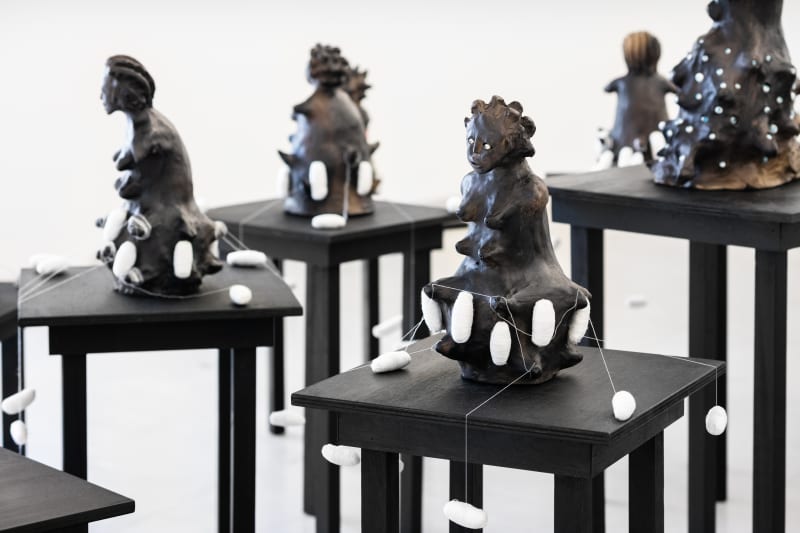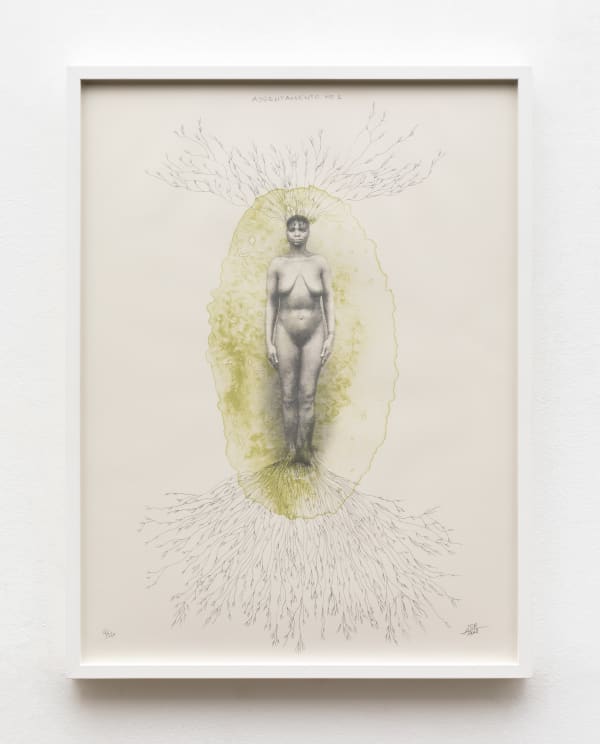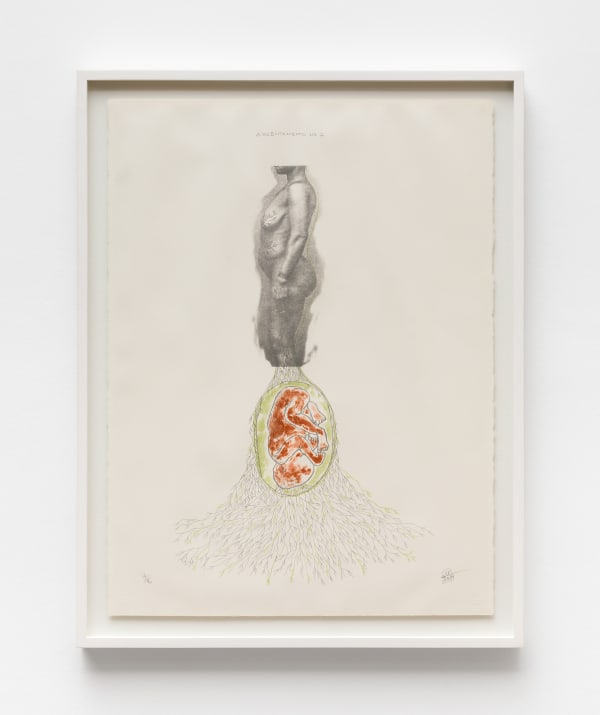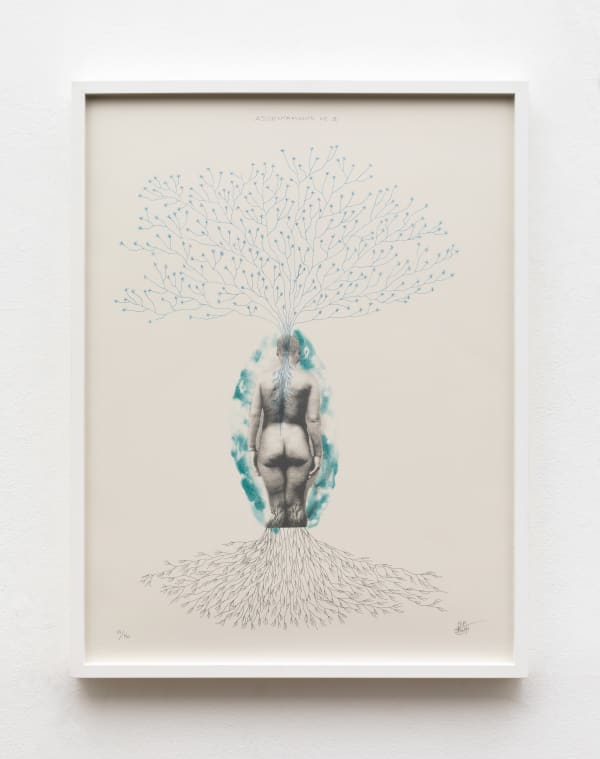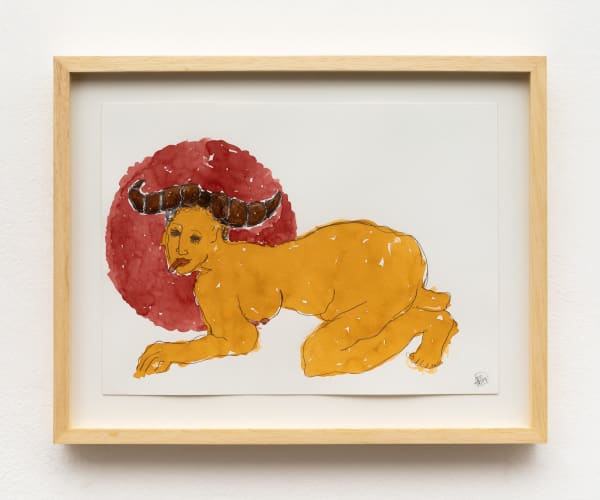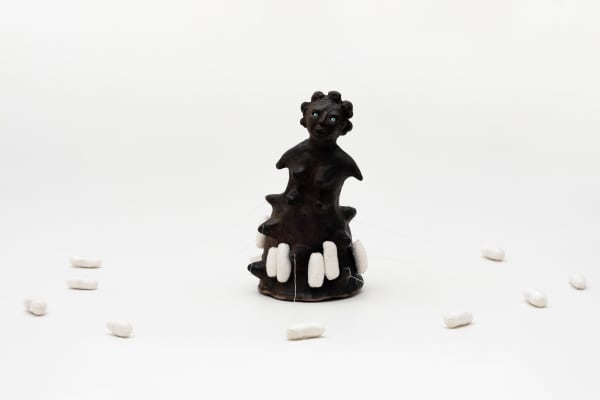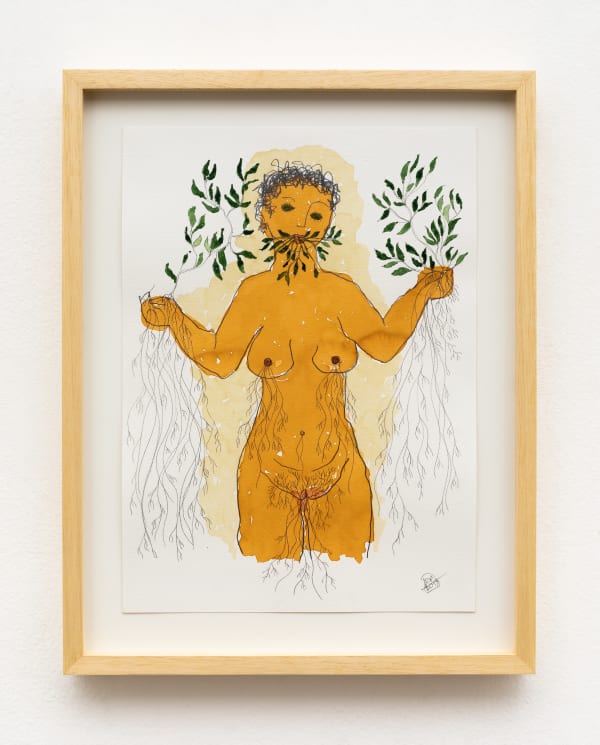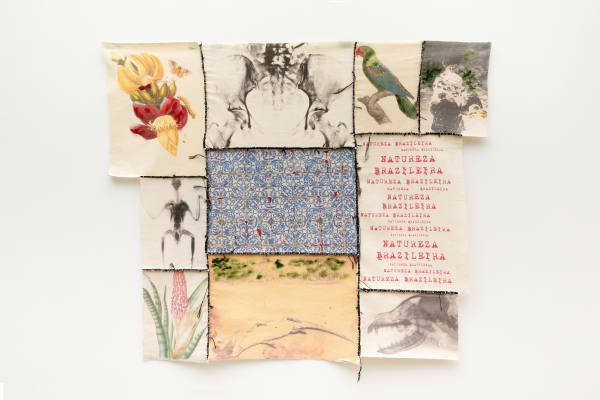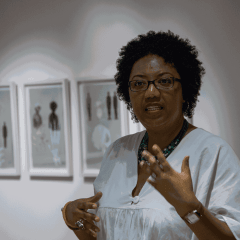BÚFALA Rosana Paulino
Past exhibition
Overview
It is with great pleasure that Mendes Wood DM São Paulo presents BÚFALA (in Portuguese, female buffalo), Rosana Paulino’s first solo show at the gallery. The exhibition brings together recent and earlier works in which the São Paulo-born artist uses multiple media, such as drawing, textile and sculpture.
Since the 1990s, Paulino has explored the historicity of images and the impact of memory on psychosocial constructions, introducing different references that intersect the artist’s personal history with the phenomenological history of Brazil, as it was constructed in the past and still persists today. Her research includes the construction of myths – not only as aesthetical pillars but also as psychic influence-makers – from the perspective of a Black woman and beyond, from a place of non-existence of her own image.
Búfala, the series that gives the title to the exhibition, consists of a group of drawings depicting ‘animal-women’, in a clear reference to the Orisha Oya or Iansã – known in Candomblé as the mother of dusk, the deity who controls the storms and the winds. However, this is not a mere illustration but rather a reflection on the archetypal power held by the Orisha. In one of the many versions of the myth, the Orisha Ogum named Oya as Iansã. The story goes that he was hunting in the forest when a buffalo crossed his path with great speed and strength. Ogum then followed the animal, and while watching it from a distance, saw the buffalo transform into a beautiful woman, who then made a bag out of her skin to keep her horns in. Iansã is this animal-woman. Her image is represented in the artist’s drawings as sexual, smart, strong women with bloody eyes, marked lips and tongues sticking out, in a reference to another non-white archetype: the Hindu goddess Kali, the divinity of destruction and rebirth, who goes to war on equal terms. As well as the animal aspect, this is an archetype of freedom, which contrasts with the flat image of Western women, who are not allowed to reveal the alternative facets of their personality: they are either a virgin or a prostitute, a saint or a witch. Búfala is an idea of a woman that cannot be constructed within Western boundaries.
Another group of drawings presents ‘vegetable-women’ with roots coming out of their breasts, vaginas, mouths, and hands. They fecundate life and spread plants. This idea of the origins of life also suggests another construction of the image of women: the image of someone whose role is to materialize things, whilst the Búfala ‘hunts’ for things around her. Myths are never a single-version story; they vary according to the context being narrated. They are an aesthetic narrative construct reflecting on human needs, which have been represented in moral narratives as an attempt to understand the psychology behind them. Paulino explores non-Christian and classic myths as an exercise to activate a memory concerned with silence, marginalization, and domination in the history of women.
The iconographic construction of colonial Brazil is also present in the series of printed fabrics that features images of Portuguese tiles, faceless women and banana bunches with the scientific name of plantain, Musa paradisiaca (Paradisiac muse). Paulino ironically combines the phallic fruit with its female name, producing an aesthetic unfamiliarity sewn into the artist’s textile works and outlining a dubious link between image and history.
Small clay sculptures depicting ‘soldier-women’ and ‘female factory workers’ are displayed in the middle of the main exhibition room. These baroque figures, with multiple breasts and tangled together by thread, constitute an army of women that is very different from the Greek goddesses or the Virgin Saints from by-gone eras. They exude sexuality but, in complete contrast to what is normally expected from female sexuality, they are aggressive, but sarcastic, suggesting an unquestionable power, even when depicted in small scale. Perhaps deliberately the installation conjures a kind of power, which stems from this fusion, while also acknowledging the image activated by the artist.
Throughout her career, Rosana Paulino – whose artistic output is unquestionably fundamental to Brazilian art – has produced a practice of reconstructing images and, beyond that, reconstructing memory and its mythologies, reflections and outcomes. Working as a drawing teacher for many years, the artist uses the medium of drawing, among others, to offers us a body of work that brings together female figures and their respective historical elements, supported by psychic traces that map colonial structures and their impact onto the social and aesthetic fabric of our time.
Since the 1990s, Paulino has explored the historicity of images and the impact of memory on psychosocial constructions, introducing different references that intersect the artist’s personal history with the phenomenological history of Brazil, as it was constructed in the past and still persists today. Her research includes the construction of myths – not only as aesthetical pillars but also as psychic influence-makers – from the perspective of a Black woman and beyond, from a place of non-existence of her own image.
Búfala, the series that gives the title to the exhibition, consists of a group of drawings depicting ‘animal-women’, in a clear reference to the Orisha Oya or Iansã – known in Candomblé as the mother of dusk, the deity who controls the storms and the winds. However, this is not a mere illustration but rather a reflection on the archetypal power held by the Orisha. In one of the many versions of the myth, the Orisha Ogum named Oya as Iansã. The story goes that he was hunting in the forest when a buffalo crossed his path with great speed and strength. Ogum then followed the animal, and while watching it from a distance, saw the buffalo transform into a beautiful woman, who then made a bag out of her skin to keep her horns in. Iansã is this animal-woman. Her image is represented in the artist’s drawings as sexual, smart, strong women with bloody eyes, marked lips and tongues sticking out, in a reference to another non-white archetype: the Hindu goddess Kali, the divinity of destruction and rebirth, who goes to war on equal terms. As well as the animal aspect, this is an archetype of freedom, which contrasts with the flat image of Western women, who are not allowed to reveal the alternative facets of their personality: they are either a virgin or a prostitute, a saint or a witch. Búfala is an idea of a woman that cannot be constructed within Western boundaries.
Another group of drawings presents ‘vegetable-women’ with roots coming out of their breasts, vaginas, mouths, and hands. They fecundate life and spread plants. This idea of the origins of life also suggests another construction of the image of women: the image of someone whose role is to materialize things, whilst the Búfala ‘hunts’ for things around her. Myths are never a single-version story; they vary according to the context being narrated. They are an aesthetic narrative construct reflecting on human needs, which have been represented in moral narratives as an attempt to understand the psychology behind them. Paulino explores non-Christian and classic myths as an exercise to activate a memory concerned with silence, marginalization, and domination in the history of women.
The iconographic construction of colonial Brazil is also present in the series of printed fabrics that features images of Portuguese tiles, faceless women and banana bunches with the scientific name of plantain, Musa paradisiaca (Paradisiac muse). Paulino ironically combines the phallic fruit with its female name, producing an aesthetic unfamiliarity sewn into the artist’s textile works and outlining a dubious link between image and history.
Small clay sculptures depicting ‘soldier-women’ and ‘female factory workers’ are displayed in the middle of the main exhibition room. These baroque figures, with multiple breasts and tangled together by thread, constitute an army of women that is very different from the Greek goddesses or the Virgin Saints from by-gone eras. They exude sexuality but, in complete contrast to what is normally expected from female sexuality, they are aggressive, but sarcastic, suggesting an unquestionable power, even when depicted in small scale. Perhaps deliberately the installation conjures a kind of power, which stems from this fusion, while also acknowledging the image activated by the artist.
Throughout her career, Rosana Paulino – whose artistic output is unquestionably fundamental to Brazilian art – has produced a practice of reconstructing images and, beyond that, reconstructing memory and its mythologies, reflections and outcomes. Working as a drawing teacher for many years, the artist uses the medium of drawing, among others, to offers us a body of work that brings together female figures and their respective historical elements, supported by psychic traces that map colonial structures and their impact onto the social and aesthetic fabric of our time.
Works
-
 Rosana Paulino, ASSENTAMENTO N. 1, 2013
Rosana Paulino, ASSENTAMENTO N. 1, 2013 -
 Rosana Paulino, ASSENTAMENTO N. 2, 2013 - 2014
Rosana Paulino, ASSENTAMENTO N. 2, 2013 - 2014 -
 Rosana Paulino, ASSENTAMENTO N. 3, 2013 - 2014
Rosana Paulino, ASSENTAMENTO N. 3, 2013 - 2014 -
 Rosana Paulino, from Búfala series, 2019
Rosana Paulino, from Búfala series, 2019 -
 Rosana Paulino, from Búfala series, 2019
Rosana Paulino, from Búfala series, 2019 -
 Rosana Paulino, from Búfala series, 2019
Rosana Paulino, from Búfala series, 2019 -
 Rosana Paulino, Operárias, 2006
Rosana Paulino, Operárias, 2006 -
 Rosana Paulino, Operárias, 2006
Rosana Paulino, Operárias, 2006 -
 Rosana Paulino, Operárias, 2006
Rosana Paulino, Operárias, 2006 -
 Rosana Paulino, Operárias, 2006
Rosana Paulino, Operárias, 2006 -
 Rosana Paulino, Operárias, 2006
Rosana Paulino, Operárias, 2006 -
 Rosana Paulino, Operárias, 2006
Rosana Paulino, Operárias, 2006 -
 Rosana Paulino, Operárias, 2006
Rosana Paulino, Operárias, 2006 -
 Rosana Paulino, Operárias, 2006
Rosana Paulino, Operárias, 2006 -
 Rosana Paulino, from Senhora das Plantas series, 2019
Rosana Paulino, from Senhora das Plantas series, 2019 -
 Rosana Paulino, Operárias, 2006
Rosana Paulino, Operárias, 2006 -
 Rosana Paulino, Operárias, 2006
Rosana Paulino, Operárias, 2006 -
 Rosana Paulino, Operárias, 2006
Rosana Paulino, Operárias, 2006 -
 Rosana Paulino, Untitled, from NATUREZA BRAZILEIRA series, 2021
Rosana Paulino, Untitled, from NATUREZA BRAZILEIRA series, 2021 -
 Rosana Paulino, Untitled, from the Musa Paradisíaca series, 2022
Rosana Paulino, Untitled, from the Musa Paradisíaca series, 2022 -
 Rosana Paulino, Paraíso Tropical, 2020
Rosana Paulino, Paraíso Tropical, 2020 -
 Rosana Paulino, Operárias, 2006
Rosana Paulino, Operárias, 2006 -
 Rosana Paulino, Operárias, 2006
Rosana Paulino, Operárias, 2006
Installation Views
